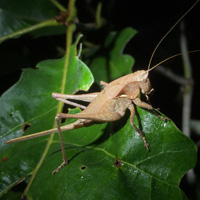Davis’s Shieldback
Scientific name: Atlanticus davisi

Photo credit: brendanboyd CC BY 4.0
Status
Threatened
“Threatened” means the species lives in the wild in Ontario, is not endangered, but is likely to become endangered if steps are not taken to address factors threatening it.
Date added to the Species at Risk in Ontario List
January 25, 2023
Read the assessment report (PDF)
What it looks like
Davis’s Shieldback is a large flightless katydid or bush cricket, about 20 to 25 mm in length. This species is grey-brown with some dark and pale mottling (spots or smears of colour). Its wings are reduced and partially hidden beneath the pronotum, a shield-like plate on the top and sides of the thorax (the area between the neck and the body).
Males have short, leathery forewings that extend a short distance beyond the pronotum and two short projections at the end of the abdomen called cerci. Females of the species have their wings entirely covered by the pronotum and a long, sword-like ovipositor (a tubular organ through which females deposit eggs) that extends out behind the abdomen.
Where it lives
Davis’s Shieldbacks live in oak woodland, oak savannah and sand barren sites with well-drained dry, sandy soils. They are most often found:
- near forest edges
- in woodland openings
- in openings along forest access roads or trails
Katydids like the Davis’s Shieldback tend to inhabit the leaf litter and above-ground shrubbery in their habitats.
Davis’s Shieldback has been recorded in southwestern Ontario, from Michigan to Vermont, and south to North Carolina and Arkansas.
Where it’s been found in Ontario
Davis’s Shieldback has only been found in Norfolk County in southwestern Ontario, in the habitats of the Norfolk Sand Plain.
What threatens it
The greatest threats to Davis’s Shieldback are habitat degradation and fragmentation of the oak savannahs and woodlands it inhabits. This degradation and fragmentation are caused by:
- changes in management practices (such as fire suppression)
- changes in land use (such as damage from off-road vehicle traffic)
- natural system modifications by plant and insect species (such as invasive species) that may degrade habitat quality
Davis’s Shieldback is a flightless species and is incapable of travelling long distances or crossing major bodies of water. As their habitat is fragmented and degraded, this species’ limited mobility makes it difficult to migrate between sites to find suitable habitat.
Other threats to Davis’s Shieldback may include:
- impact from commercial and industrial areas
- recreational activities
- roadways
- agricultural and forestry effluents (runoff)
- climate change and severe weather impacts
Action we are taking
This species and its habitat are protected under Ontario’s Endangered Species Act, 2007 (ESA).
All species listed on the Species at Risk in Ontario List may be eligible for consideration for government funding through the Species at Risk Stewardship Program.
Recovery strategy
A recovery strategy advises the ministry on ways to ensure healthy numbers of the species return to Ontario.
Read the executive summary and the full document (July 9, 2024).
What you can do
Report a sighting
Submit your observations of species at risk to the Natural Heritage Information Centre (NHIC), which is Ontario’s conservation data centre. Join the “(NHIC) Rare Species of Ontario” project in iNaturalist to make submitting your observations quick and easy.
Volunteer
Volunteer with species at risk programs, such as community science surveys, through your local nature club, a provincial park or other conservation organizations.
Be a good steward
- Private landowners have a very important role to play in species recovery. If you find species at risk on your land, you may be eligible for stewardship programs that support the protection and recovery of species at risk and their habitats, such as the Species at Risk Stewardship Program.
- Invasive species seriously threaten many of Ontario’s species at risk. To learn what you can do to help reduce the threat of invasive species, visit:
Report illegal activity
Report any illegal activity related to species at risk to
Quick facts
- The Canadian population of Davis’s Shieldback is estimated to be small, with a preliminary estimate of between 300 to 1,310 mature individuals.
- Davis’s Shieldback has one generation per year. Nymphs hatch in the spring and mature into adults that are active from July through September, perishing in below freezing temperatures.
- Adult males produce songs called stridulations by rubbing their wings. Although quiet, the male’s song is distinctive and useful for species identification and locating individuals.